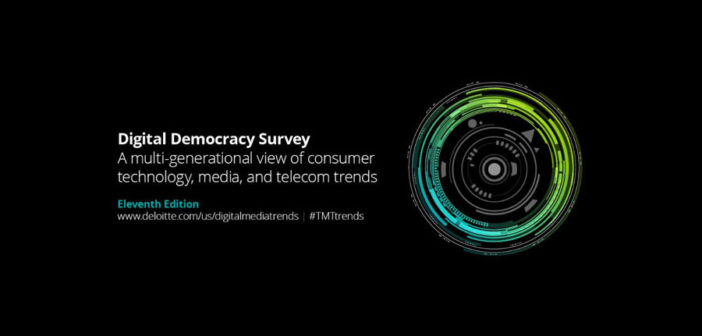Deloitte’s 11th Digital Democracy Survey finds Americans are consuming more media than ever before via streaming and binge watching, with millennials leading the charge. With 84 percent of Americans on social networks, multitasking and social network influence continue to accelerate and challenge traditional revenue models.
Ads are being skipped as consumers opt for more free content changing the revenue proposition for brands to new platforms, more product placement and geo-location ads on smartphones.
The survey focuses on how five generations of consumers, ages14 and older, are interacting with media, products and services, mobile technologies, the internet—plus their attitudes and behaviors toward advertising and social networks, and their future preferences.
The social part is core, as 84% of all consumers and more than 90% of Gen Z and millennials are active on social networks. More than 50% of Gen Z and millennials use social networks to learn about new TV shows, citing it as more useful than TV commercials, while 33% of millennials and Gen Z get their news primarily from social media.
73 Percent of Americans Binge Watch TV. Digital democracy survey, eleventh edition. Deloitte US https://t.co/tsDoYoNCX5 via @DeloitteUS
— Kevin Westcott (@kwestcott911) March 22, 2017
 Kevin Westcott (right), Deloitte’s vice chairman and U.S. media and entertainment leader, stated that “The shift to streaming, mobile, on-demand services and personalization are significant opportunities in 2017… Brands can bring new value, services and incredibly entertaining content to the empowered consumers across all age groups in a manner that can be monetized.”
Kevin Westcott (right), Deloitte’s vice chairman and U.S. media and entertainment leader, stated that “The shift to streaming, mobile, on-demand services and personalization are significant opportunities in 2017… Brands can bring new value, services and incredibly entertaining content to the empowered consumers across all age groups in a manner that can be monetized.”
With ad-skipping and -blocking the norm for millennials and Gen Z, we asked Westcott for further thoughts on monetization and the business model for brands in this streaming, disaggregated era. He told us:
“Relevancy remains an very important factor regardless of generation. Brands have an opportunity to leverage social channels to better understand their younger audience. Beyond that, companies can focus on producing content that will generate buzz beyond the page or airwaves and onto the social platforms that are driving the conversation for millennials and Gen Z. Some companies might choose to be more strategic with product placement in binge-watched content, which is often viewed ad-free. Others might release feature-length content as a mini-series instead, to make them more suitable for binge-watching.”
To the point about creating shorter, snackable content for different platforms, the report found that more than half of the consumers surveyed said they’re willing to receive advertising on their smartphones based on location, while 46% say they pay more attention to an ad they can skip versus an ad they cannot skip.
As Deloitte’s report notes, “Making ads more relevant—especially geographically relevant—and making the first few seconds of a skippable ads more compelling could help advertisers get through to more consumers.”
Other findings on the ad sales front:
• 67% of consumers, and over 70% of Gen Z and millennials, find mobile ads on their phone to be irrelevant; however, 37% of consumers find it valuable to receive location-based ads on their smartphone and use them regularly.
• 45% of millennials use ad-blocking software, with 89% saying their primary reason is to avoid all advertising and 40% of them noted use of ad-blocking software on their smartphones.
• Online recommendations on social media (27%) are more influential than TV ads (18%) for Gen Z in influencing buying decisions.
Deloitte's 11th annual #TMTtrends report is here! Explore a multi-generational view of #digitalmedia trends. https://t.co/AWquAYUVHh pic.twitter.com/Bn357TykCk
— Deloitte TMT (@DeloitteTMT) March 22, 2017
Among other key findings:
• Almost half (49%) of U.S. consumers and nearly 60% of generation Z (Gen Z), millennials and Generation X (Gen X) subscribe to at least one paid streaming video service. However, U.S. consumers spend more time streaming video via free services (40%) than paid streaming subscriptions (35%).
• 74% of U.S. households still subscribe to pay TV but 66 percent say they keep it because it is bundled with their internet.
• Nearly three quarters (73%) of U.S. consumers (up 3% from 2015) and nearly 90% of millennials and Gen Z have binge watched video content; almost 40% of millennial and Gen Z binge watchers do so weekly. Millennial and Gen Z binge watchers report watching an average of six episodes, or five hours of content, in a single sitting.
• The device of choice for key demographics remains split; Gen Z and millennials spend about half their time watching television shows and movies on devices other than a TV. Additionally, Gen X favors the TV by over 60% and Baby Boomers watch over 80% of programming on the TV.
• Nearly all (99%) millennials and Gen Z are multitasking while watching TV, averaging four additional activities, such as texting, browsing the web, using social networks, reading email and online shopping.
Regarding cord-cutting, Deloitte’s survey found 74% of consumers maintained paid TV subscriptions in 2016. “We’ve really not seen much in the way of cord-cutting,” Westcott told CNBC. “There is some, but consumers who do have these bundled services — internet access is now like any other utility. If they have bundled service, they’re much less likely to cut the cord.”
–
This article first appeared in www.brandchannel.com
Seeking to build and grow your brand using the force of consumer insight, strategic foresight, creative disruption and technology prowess? Talk to us at +9714 3867728 or mail: info@groupisd.com or visit www.groupisd.com


